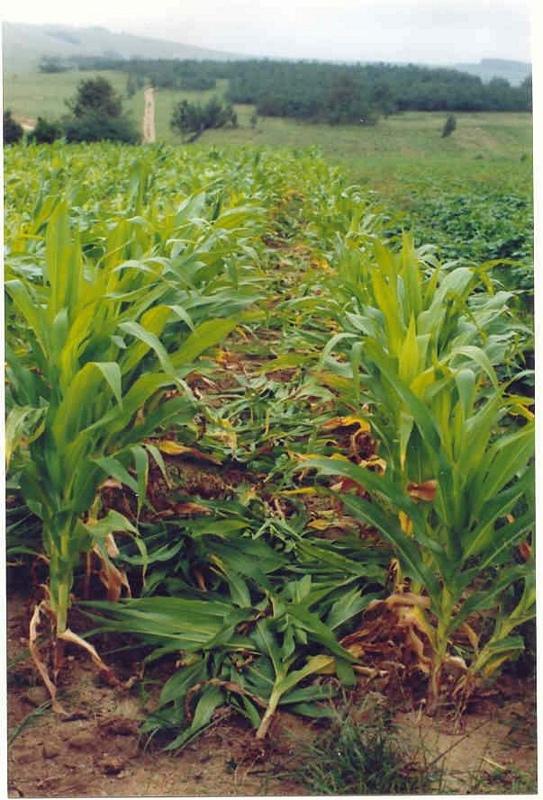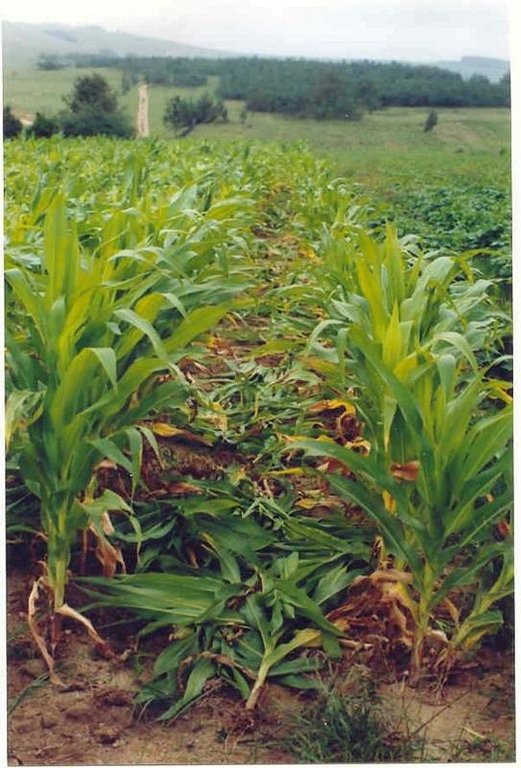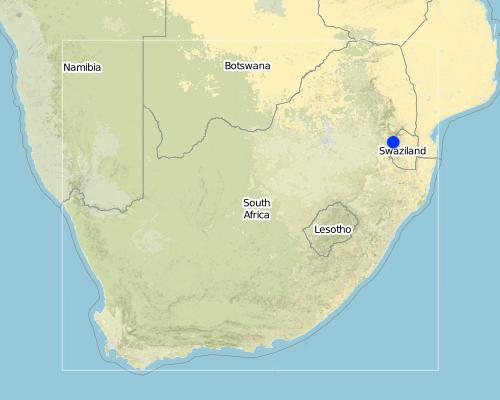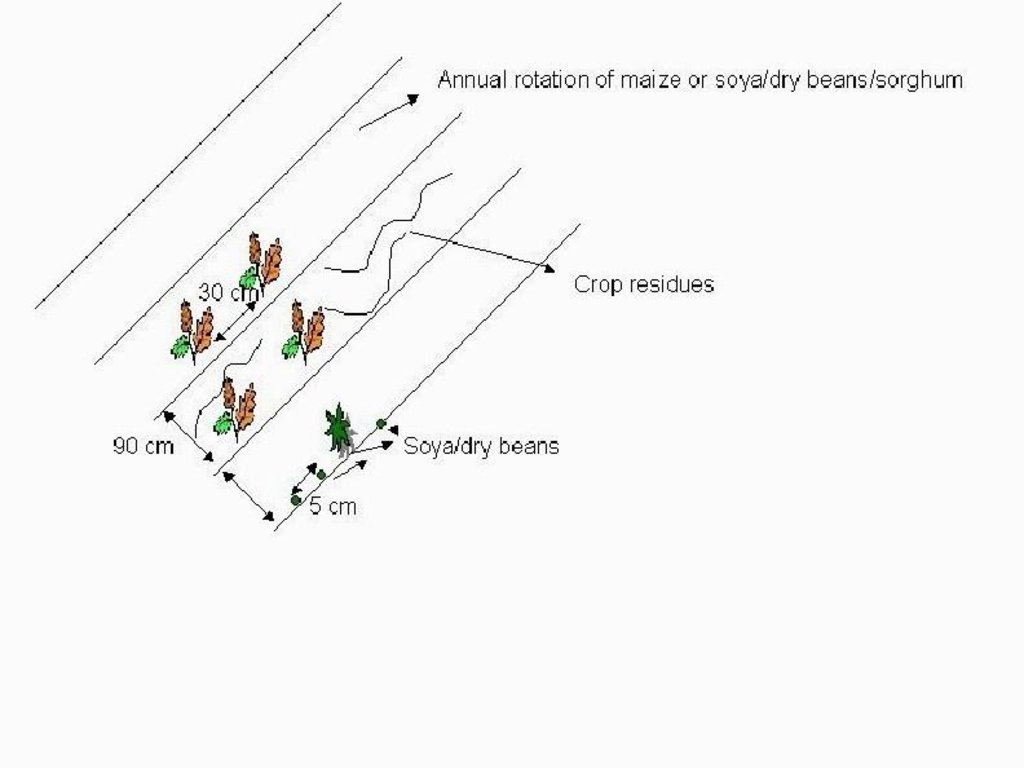Conservation Agriculture [南非]
- 创建:
- 更新:
- 编制者: Hester Gertruida Jansen van Rensburg
- 编辑者: –
- 审查者: David Streiff
Planting without ploughing/no-till
technologies_976 - 南非
查看章节
全部展开 全部收起1. 一般信息
1.2 参与该技术评估和文件编制的资源人员和机构的联系方式
有助于对技术进行记录/评估的机构名称(如相关)
Agricultural Research Council (ARC) - 南非1.3 关于使用通过WOCAT记录的数据的条件
(现场)数据是什么时候汇编的?:
26/11/2001
编制者和关键资源人员接受有关使用通过WOCAT记录数据的条件。:
是
1.5 请参阅有关SLM方法的问卷
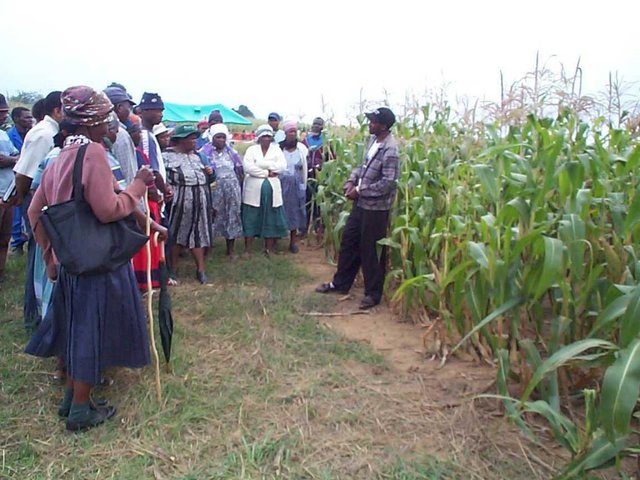
Farmers involved in own development [南非]
Planting without ploughing in a crop rotation system to improve moisture management, reduce erosion and increase crop yield.
- 编制者: Hester Gertruida Jansen van Rensburg

Multi-stakeholder LandCare process [南非]
A multi-stakeholder approach using action research methodologies to implement conservation agriculture
- 编制者: Hendrik Johannes Smith
2. SLM技术的说明
2.1 技术简介
技术定义:
Conservation agriculture included aspects such as crop rotation, mulching and no-tillage.
2.2 技术的详细说明
说明:
The goal of conservation agriculture is to maintain and improve crop yields and at the same time protect and stimulate the biological binding functioning of the soil. The essential features of conservation agriculture are no-tillage, maintenance of cover (live or dead vegetal material) and crop rotation. Crops are planted through the cover with special equipment or (in the case of Mlondozi) by making holes in the ground with a hand hoe.
Soil cover inhibits erosion and the germination of weed seeds; it improves soil and water retention and reduces compaction.
Crop-seeds are planted without prior ploughing. If a plough sole exists, soil has to be ripped, if not, crop seeds can be planted. It is advisable to move gradually from tillage to no-tillage over a period of 4-5 years, starting with a crop that produces enough organic material (2-3 ton dry material annually).
2.3 技术照片
2.5 已应用该技术的、本评估所涵盖的国家/地区/地点
国家:
南非
区域/州/省:
Mpumalanga
有关地点的进一步说明:
Mlondozi
Map
×2.6 实施日期
如果不知道确切的年份,请说明大概的日期:
- 不到10年前(最近)
2.7 技术介绍
详细说明该技术是如何引入的:
- 通过项目/外部干预
注释(项目类型等):
Technology was implemented in several countries in the world e.g. Brasilia/Argentina/Australia/North America and African countries such as Zimbabwe, Zambia, e.g.
3. SLM技术的分类
3.1 该技术的主要目的
- 改良生产
- 减少、预防、恢复土地退化
- 保护生态系统
3.2 应用该技术的当前土地利用类型

农田
- 一年一作
主要农作物(经济作物及粮食作物):
major cash crop and major food crop: Maize
注释:
Major land use problems (compiler’s opinion): - Soil compaction (plough layer) . - Reduced soil fertility. - Soil acidity. - Overgrazing. - Lack of implements. - Lack of land tenure.
Major land use problems (land users’ perception): - Lack of land tenure. - Lack of money.
3.3 有关土地利用的更多信息
该技术所应用土地的供水:
- 雨养
每年的生长季节数:
- 1
具体说明:
Longest growing period in days: 170; Longest growing period from month to month: Nov - Apr
3.4 该技术所属的SLM组
- 改良的地面/植被覆盖
- 最小的土壤扰动
- 土壤肥力综合管理
3.5 技术传播
具体说明该技术的分布:
- 均匀地分布在一个区域
如果该技术均匀地分布在一个区域上,请注明覆盖的大致区域。:
- 1-10 平方千米
注释:
Total area covered by the SLM Technology is 5.2 km2.
Total technology area is approximately 300 ha.
3.6 包含该技术的可持续土地管理措施

农艺措施
- A3:土壤表面处理

植物措施

结构措施

管理措施
注释:
Main measures: agronomic measures, vegetative measures, management measures
Secondary measures: structural measures
Type of agronomic measures: better crop cover, mulching, mineral (inorganic) fertilizers, rotations / fallows, breaking compacted topsoil, zero tillage / no-till, breaking compacted subsoil
3.7 该技术强调的主要土地退化类型

土壤水蚀
- Wt:表土流失/地表侵蚀
- Wg:冲沟侵蚀/沟蚀

化学性土壤退化
- Cn:肥力下降和有机质含量下降(非侵蚀所致)

水质恶化
- Ha:干旱化
注释:
Secondary types of degradation addressed: Wt: loss of topsoil / surface erosion, Wg: gully erosion / gullying
Main causes of degradation: other human induced causes (specify) (Agricultural causes), other natural causes (avalanches, volcanic eruptions, mud flows, highly susceptible natural resources, extreme topography, etc.) specify, education, access to knowledge and support services (Lack of knowledge)
Secondary causes of degradation: over-exploitation of vegetation for domestic use, overgrazing, land tenure (No land deeds), poverty / wealth (Lack of captial)
3.8 防止、减少或恢复土地退化
具体数量名该技术与土地退化有关的目标:
- 防止土地退化
- 减少土地退化
4. 技术规范、实施活动、投入和成本
4.1 该技术的技术图纸
4.2 技术规范/技术图纸说明
Technical drawing
Location: Mlondozi. Mpumalanga
Technical knowledge required for field staff / advisors: moderate
Technical knowledge required for land users: low
Main technical functions: improvement of ground cover, increase in organic matter, increase of infiltration, increase / maintain water stored in soil, improvement of soil structure
Secondary technical functions: control of raindrop splash, control of dispersed runoff: retain / trap, control of dispersed runoff: impede / retard, control of concentrated runoff: retain / trap, control of concentrated runoff: impede / retard, control of concentrated runoff: drain / divert, increase of surface roughness, water harvesting / increase water supply, sediment retention / trapping, sediment harvesting, reduction in wind speed, increase in soil fertility
Better crop cover
Material/ species: maize/grass
Mulching
Material/ species: maize/legume
Agronomic measure: removing less vegetation cover
Material/ species: maize
Mineral (inorganic) fertilizers
Material/ species: 2:3:2 (22)
Soil conditioners (lime, gypsum)
Material/ species: lime
Rotations / fallows
Material/ species: soya/any beans
Major change in timing of activities: systems approach
Other type of management: change of management / intensity level
4.3 有关投入和成本计算的一般信息
其它/国家货币(具体说明):
Rand
注明美元与当地货币的汇率(如相关):1美元=:
10.0
4.4 技术建立活动
| 活动 | 措施类型 | 时间 | |
|---|---|---|---|
| 1. | Exclude animals from field | 管理 | Feb - April |
| 2. | Fencing | 管理 | Once |
| 3. | Spraying of weeds | 管理 | October |
4.5 技术建立所需要的费用和投入
注释:
Duration of establishment phase: 48 month(s)
4.6 维护/经常性活动
| 活动 | 措施类型 | 时间/频率 | |
|---|---|---|---|
| 1. | No-tillage | 农业学的 | Oct/Nov / Once with ploughing |
| 2. | Crop rotation | 农业学的 | Oct/Nov / Every second year rotation |
| 3. | Keep lands weed free | 管理 | Dec - Jan / Once - 3 times |
4.7 维护/经常性活动所需要的费用和投入(每年)
| 对投入进行具体说明 | 单位 | 数量 | 单位成本 | 每项投入的总成本 | 土地使用者承担的成本% | |
|---|---|---|---|---|---|---|
| 肥料和杀菌剂 | Pesticide | ha | 1.0 | 20.0 | 20.0 | |
| 肥料和杀菌剂 | Save - ploughing | ha | 1.0 | 40.0 | 40.0 | |
| 技术维护所需总成本 | 60.0 | |||||
4.8 影响成本的最重要因素
描述影响成本的最决定性因素:
High weed population
5. 自然和人文环境
5.1 气候
年降雨量
- < 250毫米
- 251-500毫米
- 501-750毫米
- 751-1,000毫米
- 1,001-1,500毫米
- 1,501-2,000毫米
- 2,001-3,000毫米
- 3,001-4,000毫米
- > 4,000毫米
指定年平均降雨量(若已知),单位为mm:
800.00
农业气候带
- 半干旱
Short season, cold winters (moderate climate)
5.2 地形
平均坡度:
- 水平(0-2%)
- 缓降(3-5%)
- 平缓(6-10%)
- 滚坡(11-15%)
- 崎岖(16-30%)
- 陡峭(31-60%)
- 非常陡峭(>60%)
地形:
- 高原/平原
- 山脊
- 山坡
- 山地斜坡
- 麓坡
- 谷底
垂直分布带:
- 0-100 m a.s.l.
- 101-500 m a.s.l.
- 501-1,000 m a.s.l.
- 1,001-1,500 m a.s.l.
- 1,501-2,000 m a.s.l.
- 2,001-2,500 m a.s.l.
- 2,501-3,000 m a.s.l.
- 3,001-4,000 m a.s.l.
- > 4,000 m a.s.l.
5.3 土壤
平均土层深度:
- 非常浅(0-20厘米)
- 浅(21-50厘米)
- 中等深度(51-80厘米)
- 深(81-120厘米)
- 非常深(> 120厘米)
土壤质地(表土):
- 中粒(壤土、粉土)
- 细粒/重质(粘土)
表土有机质:
- 中(1-3%)
- 低(<1%)
如有可能,附上完整的土壤描述或具体说明可用的信息,例如土壤类型、土壤酸碱度、阳离子交换能力、氮、盐度等。:
Soil fertility is low - medium
Soil drainage / infiltration is medium
Soil water storage capacity is medium
5.6 应用该技术的土地使用者的特征
生产系统的市场定位:
- 生计(自给)
非农收入:
- > 收入的50%
相对财富水平:
- 贫瘠
- 非常丰富
机械化水平:
- 手工作业
- 机械化/电动
说明土地使用者的其他有关特征:
65% of the land users are very rich.
5% of the land users are average wealthy.
30% of the land users are poor.
Off-farm income specification: Pensions to by inputs.
Level of mechanization: Animal traction is possible, but less common
5.7 应用该技术的土地使用者拥有或租用的平均土地面积
- < 0.5 公顷
- 0.5-1 公顷
- 1-2 公顷
- 2-5公顷
- 5-15公顷
- 15-50公顷
- 50-100公顷
- 100-500公顷
- 500-1,000公顷
- 1,000-10,000公顷
- > 10,000公顷
注释:
Average area of land owned or leased by land users applying the Technology: Also 5-15 ha
5.8 土地所有权、土地使用权和水使用权
土地所有权:
- 个人,未命名
土地使用权:
- 租赁
6. 影响和结论性说明
6.1 该技术的现场影响
社会经济效应
生产
作物生产
SLM之前的数量:
0.5 t/ha
SLM之后的数量:
4.5 t/ha
饲料生产
饲料质量
收入和成本
工作量
社会文化影响
社区机构
注释/具体说明:
Groups formed - meetings
SLM/土地退化知识
注释/具体说明:
Monitored
生态影响
水循环/径流
多余水的排放
土壤
土壤水分
土壤覆盖层
SLM之前的数量:
10 %
SLM之后的数量:
50 %
其它生态影响
soil fertility
biodiversity
注释/具体说明:
Introduction of multi purpose crops/legumes.
6.2 该技术的场外影响已经显现
下游洪水
6.4 成本效益分析
技术收益与技术建立成本相比如何(从土地使用者的角度看)?
短期回报:
非常积极
长期回报:
非常积极
技术收益与技术维护成本/经常性成本相比如何(从土地使用者的角度看)?
短期回报:
非常积极
长期回报:
非常积极
6.5 技术采用
- 大于 50%
如若可行,进行量化(住户数量和/或覆盖面积):
220 households
在所有采用这项技术的人当中,有多少人是自发地采用该技术,即未获得任何物质奖励/付款?:
- 10-50%
注释:
200 land user families have adopted the Technology with external material support
Comments on acceptance with external material support: survey results
20 land user families have adopted the Technology without any external material support
Comments on spontaneous adoption: estimates
There is a moderate trend towards spontaneous adoption of the Technology
6.7 该技术的优点/长处/机会
| 土地使用者眼中的长处/优势/机会 |
|---|
|
Increase yields How can they be sustained / enhanced? Training |
| Cheaper way of planting |
|
Improve water infiltration How can they be sustained / enhanced? Mulch |
|
Reduce erosion How can they be sustained / enhanced? Mulch |
| Time saving |
| 编制者或其他关键资源人员认为的长处/优势/机会 |
|---|
|
Early planting - not dependant on tractors and ploughs How can they be sustained / enhanced? Training |
|
Soil - reduce soil erosion How can they be sustained / enhanced? Increase in organic material in soil |
|
Weed control - reduce weed population How can they be sustained / enhanced? Use of herbicides |
|
Improve water retention - lower risk of draught periods How can they be sustained / enhanced? Mulch |
|
Reduction in input cost (R500/ha) Increase yields |
6.8 技术的弱点/缺点/风险及其克服方法
| 土地使用者认为的弱点/缺点/风险 | 如何克服它们? |
|---|---|
| Lack of no-till implements |
| 编制者或其他关键资源人员认为的弱点/缺点/风险 | 如何克服它们? |
|---|---|
| Lack of mechanisation of no-till implements | Exposure to implements |
7. 参考和链接
7.2 参考可用出版物
标题、作者、年份、ISBN:
Demonstration & Assessment of sustainable land management practices in the Mlondozi district of Mpumalanga. Du Preez, Kidson, Beukes & Smith. 1998/1999/2000.
可以从哪里获得?成本如何?
ARC - ISCW
链接和模块
全部展开 全部收起链接

Farmers involved in own development [南非]
Planting without ploughing in a crop rotation system to improve moisture management, reduce erosion and increase crop yield.
- 编制者: Hester Gertruida Jansen van Rensburg

Multi-stakeholder LandCare process [南非]
A multi-stakeholder approach using action research methodologies to implement conservation agriculture
- 编制者: Hendrik Johannes Smith
模块
无模块


